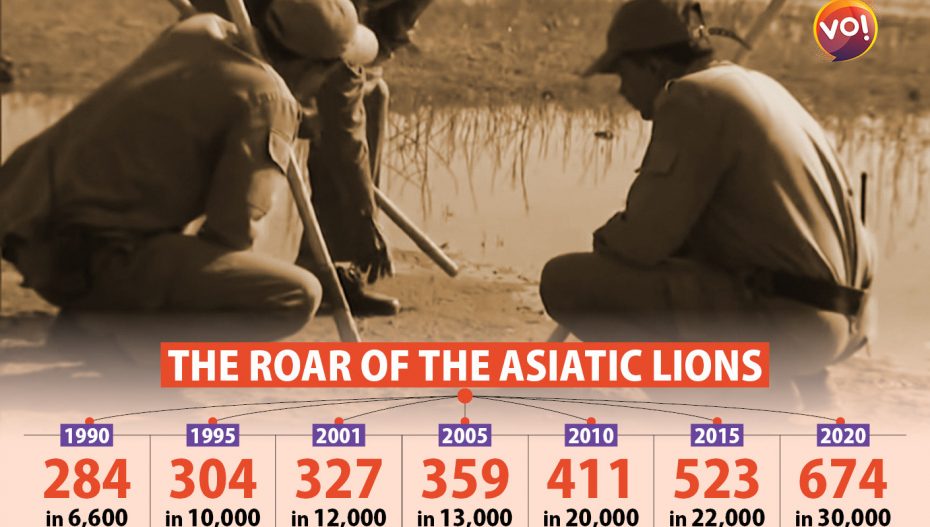Prime Minister Narendra Modi’s tweet on World Lion Day has swivelled the spotlight once again on the pride of Gujarat — the Asiatic lions who are showing robust growth in numbers — but hidden in the shadows of that feat are many unsung heroes, the guardians of the king of the jungle.
According to the results of the last lion census — carried out once every five years — declared in June last year, the number of Asiatic lions in Gujarat grew to 674 in 2020 from 523 in 2015.
The forest department, the local communities and everyone associated with conservation can rightly take credit for that. However, the real heroes are the unknown foot soldiers — area and forest experts who work far away from the limelight.
They are known as wildlife trackers.
The essential work of these wildlife trackers often tends to escape the official recognition and appreciation, but they are the pillars of the lion conservation program.
An incident during the census data collection of 1990 throws light on the skill and the occupational hazards of these trackers. One such tracker, Dhanabhai, accompanying a forest official on census duty, warned the official against clicking photos of a mating lion couple. The official ignored the warning.
Enraged, the lion charged at the officer. It was only due to the timely and clever intervention of Dhanabhai that the official was saved and the lion made to return to his territory.
“Inheriting legacies from their ancestors — great grandfathers, uncles and fathers — trackers are born gifted and show exemplary bravery,” said a tracker who wanted to remain anonymous.
“Trackers do this work despite non-lucrative salaries, without paid leave or vacations. Often they work voluntarily. But they are often neglected for the same bravery they display. The contract system keeps us without any remuneration for 3-4 months at a stretch and we do not have any proper weapons too for our self-defence,” the tracker said.
“Also, when tragedy strikes and if any tracker is attacked by a lion or other animal and gets injured, the help that is extended to us for such instances is often delayed and we are rendered helpless,” he added.
The tracker said the “biggest challenge is the problem of not being absorbed as permanent employees.”
He explained: “With danger lurking over us always, we are on guard 24×7. We have been given np raise in the past two years. Efforts were made by IFS officer Mohan Ram, who worked very hard to ensure we trackers are absorbed as permanent employees and our remuneration structure is also changed. But the administration and the government did not pay heed to it and because of their internal politics the efforts did not succeed.”
Trackers are seldom armed; if required they keep an axe or a long stick. Their safety is pinned to the hope that the lions have got used to their presence and will not attack them.
However, any wild animal is unpredictable, and this is an apex predator. There are reasons why a lion gets aggressive, too; like if it has recently killed a prey, or when a lioness has given birth and gets extra cautious for her cubs’ safety.
Many times, memories of recent bad experiences or external attacks on them trigger attack-responses in lions which pose a danger for these trackers.
It is perhaps safe to say that there comes a moment of dread in the life of these each of these trackers — when they run into an unfortunate situation, facing an angry big cat unarmed.
Vibes of India spoke to Range Forest Officer Rasila Vadher, who has been associated with Sasan for the last 13 years, to understand more about the trackers’ plight.
“Gir and its surroundings, areas where lions have found safe refuge, has roughly around 160 such wildlife foot soldiers or trackers, out of which around 18 are associated with the Sasan Wildlife Sanctuary,” Vadher explained.
“Under the Gujarat State Lion Conservation Society trust set up by the government of Gujarat, these trackers are employed on contract basis for 11 months. In accordance with the number of lions present in an area, each tracker is assigned a certain number of lions to be monitored and they keep following the lions’ movement on their motorcycles and on foot when deep within the jungle.”
These trackers, she said, are given Rs 12,000 per month and a raise of 10 per cent every five years.
“Along with the remuneration, they are given health insurance, special footwear while they roam on foot in the forest and are also offered accommodation with the government housing premises. In case of an unfortunate event of death of a tracker due to any attack by the wild animals, the Gujarat State Lion Conservation Society trust helps the deceased’s family with up to Rs 4 lakh,” Vadher said.
As every Gujarati — and every Indian — rightly takes pride in the growing numbers of Asiatic lions, let us not forget these unsung heroes working away from the limelight to save the flora and fauna that make India incredible.












